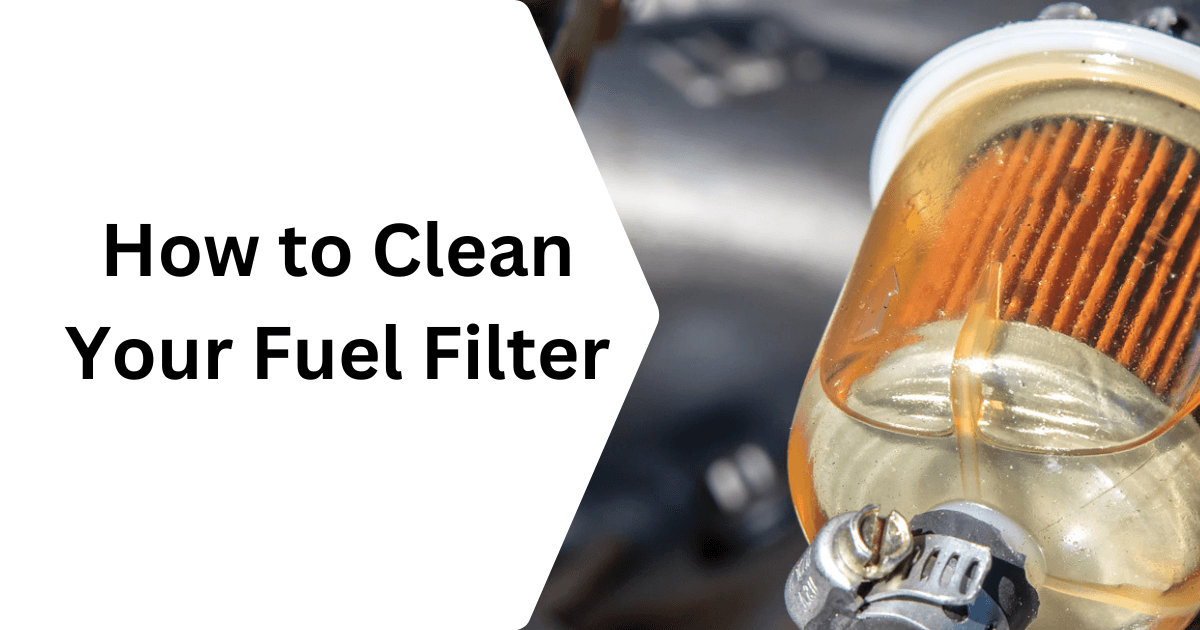Table of Contents
Introduction
A fuel filter is a tool in your car’s fuel system that traps and removes dirt and impurities such as dust, rust, and debris from fuel (gasoline or diesel) before it reaches the engine.
Dirt in the fuel line can clog up important parts like the carburetor or fuel injector. Learning how to clean your fuel filter is important to keep your car running well. A dirty fuel filter can make your engine run poorly because it blocks the flow of gasoline. This makes your car lose power and not respond well when you try to speed up. If your fuel filter is dirty, your car might not start on some occasions. You need to clean your fuel filter regularly, which we will cover in this guide today. If your filter is nylon or paper, you may need to replace it with a new one and if it’s made of metal and isn’t too grimy, you can clean and reuse it.
5 Signs That Shows You Need to Change Your Fuel Filter
- Engine stalls or misfires: If your car stops suddenly or shakes when you’re driving, it could mean your fuel filter is blocked. When the filter is dirty or blocked, it can stop enough fuel from getting to the engine, causing it to stall or not run smoothly, especially when trying to speed up. This can be annoying and even dangerous, especially when driving on busy roads.
- Difficulty starting the vehicle: If your car is hard to start or you must wait more than 15 seconds before it starts, your fuel filter may be blocked. This problem might be worse when it’s cold or if the car has been sitting for a while. If you have to try several times before the car starts, it could be a sign that the fuel isn’t flowing right. If starting your car becomes a regular problem, it might mean the fuel filter needs to be checked or replaced.
- Idling is rough: If your car shakes a lot or feels like it will stop while it’s just sitting there running, this might mean there’s a problem with your fuel filter. This often happens when you’re stopped at a light or just turning the engine on. This can be uncomfortable and might harm your engine over time. If your car feels jumpy or shaky when idling, it’s probably a good time to check and replace your fuel filter to help your car run smoothly and steadily.
- Low fuel efficiency: If your car isn’t going as far on a tank of gas as it used to, it might be because your fuel filter is clogged. Seeing a sudden drop in fuel efficiency signals that something might not be right with the fuel system. This can be quite noticeable on longer trips or if you track your gas mileage regularly. It’s worth checking out the fuel filter, as a simple replacement could restore your car’s efficiency and save you money on gas in the long run.
- Engine power loss: Another sign that your fuel filter needs attention is a noticeable loss of engine power. If your car feels slow, especially when accelerating or climbing hills, it could be due to a restricted fuel filter. Loss of power can make driving feel slow and laborious, and it can also be risky when you need quick acceleration, like when merging onto highways. When the filter is clogged, insufficient fuel reaches the engine, and it can’t generate as much power as it needs to perform well.
Tools and Materials Needed
You’ll need a few basic tools and materials to clean your fuel filter: a suitable wrench set or pliers for removing the filter, a clean cloth or brush for cleaning, and a container for safely disposing of any residual fuel. Safety gear such as gloves and goggles is also important to protect yourself from fuel splashes and fumes. Ensure you have a new fuel filter if the current one is beyond cleaning and needs replacement.
How to Clean Your Fuel Filter: A Step-by-Step Guide
Before you begin the cleaning process, it’s important to prepare both your vehicle and your workspace. Your vehicle has to be on a flat, stable surface, and the engine is cool to prevent burns. Remove the battery to avoid any electrical issues.
Don’t forget to relieve the fuel system pressure according to your vehicle’s instructions, usually found in the owner’s manual. This is important to prevent fuel from spraying when disconnecting the fuel filter. Clear your workspace of unnecessary items and have a fire extinguisher nearby as a safety precaution.
Step 1: Jack Up Your Car If Necessary
If your fuel filter is underneath your car, you might need to lift it with a jack. This gives you enough space to work comfortably and safely. Make sure to secure the car properly on jack stands to prevent accidents while you’re working under it.
Step 2: Find the Fuel Filter
First, locate your car’s fuel filter. Start at the fuel line coming out of your carburetor or fuel injector and trace it to the filter.
Locations vary by make and model, so check your owner’s manual. It’ll be along the fuel line between the engine and gas tank. A common spot is under the car, just past the fuel pump. In some models, it’s housed in the engine bay.
Some filters, like nylon ones, are see-through, so you can easily see if they are dirty. Others might be yellow or orange, which can help you tell if they’re dirty by how dark they look. Note that glass fuel filters are also available but can break more easily.
Step 3: Clamp the Fuel Filter
Before removing the filter, use hose clamps to pinch the fuel line about 4 inches from the filter on both sides. Tighten these clamps with a flat-head screwdriver to ensure little to no gasoline leaks out when you remove the filter. Look for an arrow on the filter showing which way the fuel flows. If you can’t see an arrow, take a picture to help you remember the correct direction when you put it back.
Step 4: Removing the Fuel Filter
Always wear safety glasses to protect your eyes from any splashing fuel. Place a container under the filter to save any gasoline as you remove it. Unscrew the clamps (not the ones you just tightened) and gently remove the hoses from the filter. You’ll either use a flathead screwdriver to pop them out or pull them out by hand, letting excess gasoline drain into your container.
Fuel filters usually sit in a bracket or cradle. Carefully push the filter out without damaging it, then empty out any remaining fuel by shaking out the excess. Check your manual or look online for your vehicle’s design
Step 5: Clean The Dirty Fuel Filter
Drain any leftover gasoline from the filter. Some gas could remain inside. If you have an old glass fuel filter, you can unscrew the ends and clean the inside parts with a cloth.
You must flush out most other filters since they can’t be opened. Use a carburetor cleaner like B-12 Chemtool for this, but first check with a store or mechanic to ensure it’s safe for your filter.
Attach the straw to the B-12 Chemtool, hold the filter over your container, and spray into the ‘fuel-in’ side while tapping the filter to loosen dirt. Repeat this from both sides to ensure it’s thoroughly cleaned.
You can also use a pressurized cleaner, which should be available at your local automotive store. Ask an employee to recommend a product safe for fuel filters.
After cleaning the filter and seeing no more dirt, set it aside to dry for about an hour. Ensure it’s completely dry to avoid getting more dirt in your fuel line.
Step 6: Reattaching the Fuel Filter
Once the filter is dry, put it back in its bracket or cradle. Make sure it’s the right way by referring to the arrow or the picture you took earlier. Reconnect the fuel line hoses to the ‘in’ and ‘out’ nozzles on the filter. Tighten the clamps with your screwdriver. Finally, remove the clamps that were pinching the fuel line only after you’ve secured everything else.
Step 7: Lower Your Car and Reconnect the Battery and Fuse
Once you’ve securely reattached the fuel filter, carefully lower your car back to the ground if you had it jacked up. After the car is safely on the ground, reconnect the battery and fuse that you disconnected before starting the work. This is important to restore power to your car’s electrical system, ensuring that everything functions correctly when you start the engine.
How To Test Your Car After Cleaning The Fuel Filter
After cleaning or replacing the fuel filter in your car, it’s important to conduct a thorough test to ensure everything is working properly. This will help you catch potential issues early and confirm that the fuel system is in good shape. Here’s how to test your car effectively:
Start the Engine
Start the engine to see how it responds. A smooth and quick start can indicate that the fuel filter is functioning well and allowing an uninterrupted fuel flow. Listen for any unusual sounds like sputtering or hesitation that might suggest there are still issues with the fuel system. These could be signs that the filter is still clogged or was not installed correctly.
Check for Leaks
Once the engine is running, do a visual check around the fuel filter area for any signs of leaks. Make sure all connections where the fuel filter attaches to the fuel line are secure. Leaks can be spotted as drips or a small fuel pool forming under the car. Even a small leak can lead to bigger problems, so it’s crucial to address any issues immediately.
Observe the Idle
Let your car idle for a few minutes and pay attention to the engine’s behavior. It should idle smoothly without fluctuating RPMs or shaking. Rough idling can be an indicator that the fuel filter is either still blocked or there’s another issue within the fuel system needing attention.
Take a Test Drive
Drive your car on various types of roads and at different speeds to check the overall engine performance. Pay attention to how the car accelerates and responds to your inputs. Any stuttering, hesitation, or difficulty accelerating could be a sign that the fuel filter is not allowing enough fuel to meet the engine’s demands.
Monitor Fuel Efficiency
Over the next few days, keep an eye on your car’s fuel efficiency. Improvements in fuel consumption can indicate a successful fuel filter cleaning. If you notice that your mileage continues to suffer, it might be worth investigating further or consulting with a professional mechanic.
Testing your car after cleaning the fuel filter is an essential step to ensure that your vehicle remains reliable and efficient. By following these steps, you can rest assured that your fuel system is in good working order and that your engine will perform at its best.
How To Maintain Your Car’s Fuel Filter
Taking care of your fuel filter is important for keeping your car running well. To avoid clogs and other problems, it’s a good idea to replace the fuel filter regularly, as your car’s manufacturer recommends—usually every 5000 to 8000 kilometers. Buying good-quality fuel from trusted fuel stations can help protect your filter because cheaper fuels often contain more dirt and debris that can block the filter. Keeping your fuel tank clean is important, as dirt and rust can build up over time and clog the filter if they get into the fuel system.
Check the fuel line and the area around the filter for any leaks or damage. Leaks can let in air and other things that can block the filter. Also, pay attention to how your car runs—problems like hard starting, rough idling, or stalling could mean the fuel filter is clogged. If you live in a cold climate, using winter-grade fuel and parking your car in a garage can help prevent the fuel from getting too thick and putting extra strain on the filter.
FAQs
How often should I change my fuel filter?
The general recommendation is to change your fuel filter every 5,000 to 8,000 kilometers, but this can vary depending on your vehicle and driving conditions. If you frequently drive in dusty or dirty environments, especially in rural Nigeria where the roads are untarred or if your fuel quality is lower, you may need to replace it more often. Always check your vehicle’s owner manual for specific guidelines on how often to change the fuel filter. If you’re not sure when to replace it, a mechanic can help you determine the right schedule based on your driving habits and vehicle condition.
What are the signs of a bad or clogged fuel filter?
Common signs of a clogged or failing fuel filter include difficulty starting the engine, rough idling, reduced power, and poor fuel efficiency. You might also experience your engine stalling or hesitating during acceleration, especially when the car is under load, like when climbing hills. These issues happen because the filter restricts the fuel flow to the engine, causing it to work harder to get enough fuel. Ignoring these signs can lead to more serious engine problems. In severe cases, a completely clogged filter can prevent the car from starting at all. If you notice any of these symptoms, it’s a good idea to check the fuel filter and replace it if necessary immediately.
Can I clean my fuel filter instead of replacing it?
Whether you can clean your fuel filter depends on the type of filter your car uses. Some older or aftermarket fuel filters are designed to be cleaned and reused, but most modern fuel filters are made with materials like paper, which can’t be cleaned effectively. These filters need to be replaced when they get clogged or dirty. You can clean your filter using a fuel filter cleaner or solvent if your filter is reusable. However, cleaning is not always as effective as replacing it, especially if the filter is very clogged or damaged.
What happens if I don’t change my fuel filter regularly?
If you don’t change your fuel filter regularly, it can become clogged with dirt and debris, restricting the flow of fuel to the engine. This can lead to poor performance, reduced fuel efficiency, and even engine damage over time. A clogged filter makes the engine work harder to draw fuel, which can cause it to overheat or misfire. In the long run, refusing to replace the fuel filter can also damage other parts of your fuel system, such as the fuel pump and injectors, and these components are much more expensive to repair or replace than a fuel filter.
Can a bad fuel filter affect fuel efficiency?
Yes, a clogged or bad fuel filter can definitely affect your fuel efficiency. When the filter is clogged, it restricts the flow of fuel to the engine, causing the engine to work harder and use more fuel than usual. This results in lower miles per gallon (MPG), meaning you’ll need to refuel more often. Replacing a clogged filter can improve fuel efficiency by ensuring a smooth flow of fuel to the engine. This not only saves you money on fuel but also helps reduce stress on your engine, allowing it to run more efficiently.




